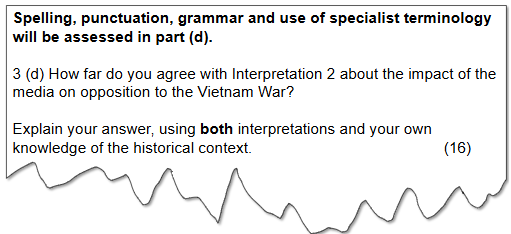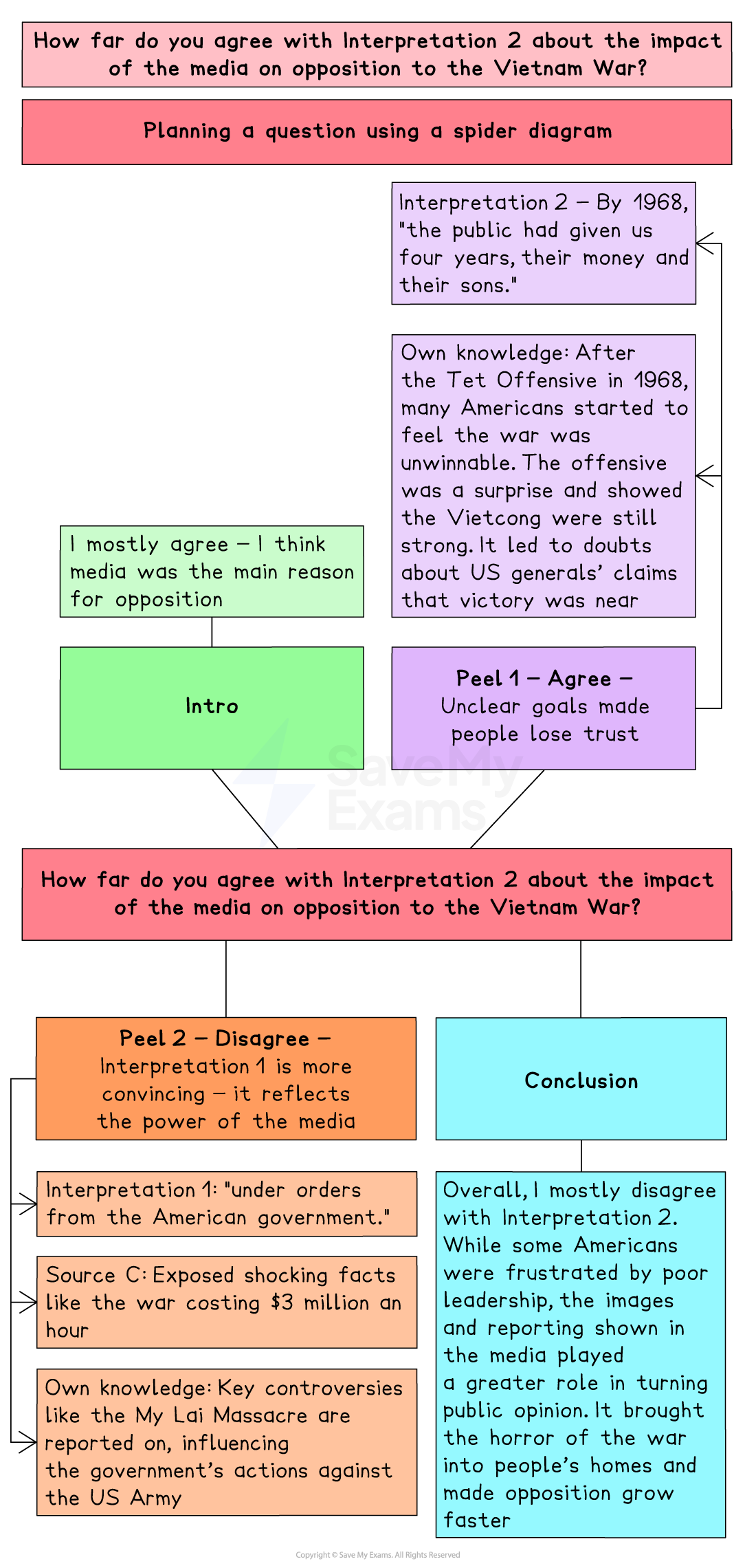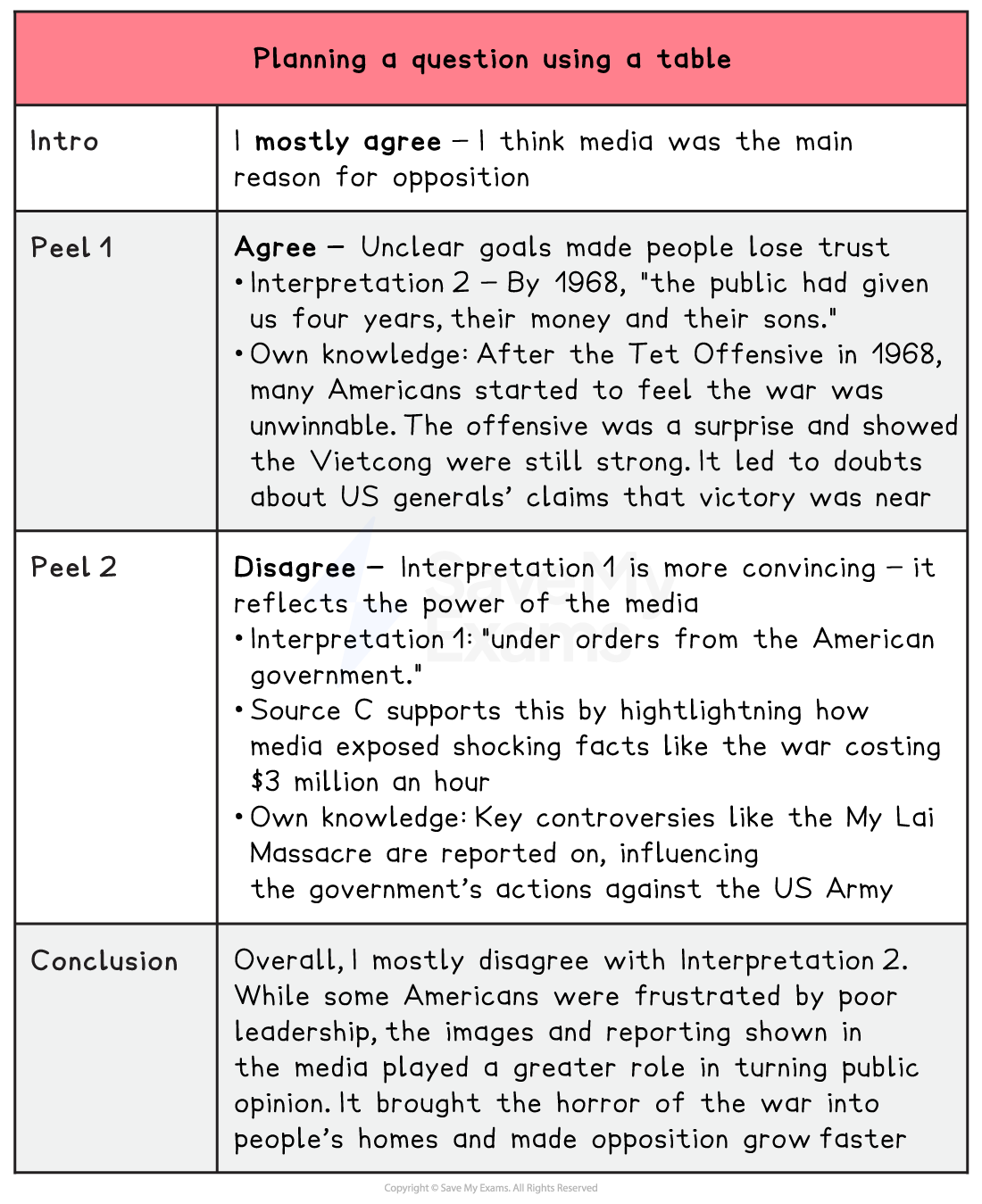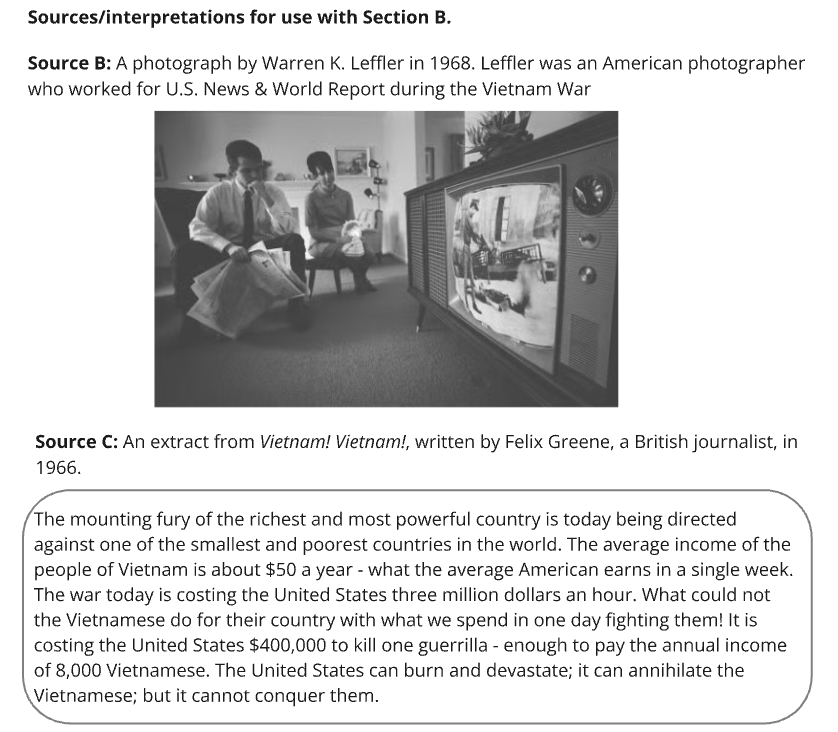The 16 Mark "How Far Do You Agree with Interpretation 2" Question (Edexcel GCSE History): Revision Note
Exam code: 1HI0
Summary of Question 3 (d)
Question 3 (d) requires you to:
Evaluate the topic outlined in the question
Use both Interpretation 1 and Interpretation 2
This will help you to have a balanced argument
Come to an overall judgement on how far you agree with the topic outlined in the question
You should use Sources B and C in your answer
They count as your own knowledge
The interpretations used in Questions 3 (b) and 3 (c) will be the same ones used in this question
Like the 16 mark question in Paper 1, you are awarded four marks for Spelling, Punctuation and Grammar (SPaG)
Amount of marks | 16 marks + 4 SPaG marks |
|---|---|
The time that you should spend on the question | 5 minutes of planning 20 minutes of writing |
An example of the type of question you may encounter can be seen below:

In previous years, this question has focused on the following topics in The USA, 1954–75:
Year of Exam
Question Topic
2018
The Tet Offensive on American attempts to win the Vietnam War (opens in a new tab)
2019
The achievements of the civil rights movement, 1960–65 (opens in a new tab)
2020
Reasons for the failure of the USA in Vietnam (opens in a new tab)
2021
The position of Black Americans in the 1950s (opens in a new tab)
2022
The methods used by the Black Panther movement (opens in a new tab)
2023
The Freedom Summer (1964) (opens in a new tab)
2024
The achievements of Martin Luther King in the civil rights movement
Making judgements in history
The 16 mark question requires you to weigh all the evidence and make a decision
Students often find this part the hardest to do
Common mistakes in judgement questions
Explaining that all of the reasons are the most important
Avoiding a clear decision by using phrases such as "kind of" or "maybe"
Giving no opinion
Changing your argument halfway through
In the example question, you state in the introduction that you fully agree with Interpretation 2
However, in the conclusion, you state that you partially agree with Interpretation 2
Doing this means that there is not a sustained judgement, and you cannot access Level 4 (13–16 marks)
What makes a good judgement?
Explain how convincing you find Interpretation 2
Consider the other interpretation
Even if you fully agree with Interpretation 2, you must also evaluate Interpretation 1
Have a consistent judgement from start to finish
Use your best evidence to back up your decision
There is no "right" or "wrong" answer in history
What makes a great conclusion in GCSE History?
Conclusions are usually where most of your judgement marks will be awarded
All great conclusions have these three elements:
Judgement — State how far you agree with Interpretation 2
Counter — Mention a reason from the other side
Support — Use your strongest evidence to explain why you have reached your judgement on Interpretation 2
How to get SPaG marks
In Paper 3, students have access to an additional 4 marks for answering Question 3 (d)
This is awarded for SPaG (Spelling, Punctuation and Grammar)
SPaG Mark | Reason for This Mark |
|---|---|
0 |
|
1 |
|
2–3 |
|
4 |
|
Top tips for boosting SPaG marks
Spell historical terms correctly
Use paragraphs
Reread your work for punctuation
Reading the answer in your head
Where you would take a breath, make sure there is a comma or a full stop
How to answer a "How far do you agree with Interpretation 2?" question
This question asks you how far you agree with Interpretation 2 on a specific topic
It will be the same topic and interpretations you used in 3 (b) and 3 (c)
In the example question, this topic is "The impact of the media on opposition to the Vietnam War"
To answer this question successfully, you should:
Read the answer carefully and multiple times (if you have the time)
Annotate:
The question to know the topic
The interpretations to come to a judgement
The sources to select what information you can use to help support your judgement
Plan your answer, including:
What parts of the interpretations and sources you wish to use
An outline of your opinion about Interpretation 2


"How far do you agree with Interpretation 2?" question structure
Your answer should include:
A logical structure
Both Interpretation 1 and Interpretation 2
The use of Source B and Source C
Do not use Source A, as you will not be awarded any marks for your comments
An explanation based on the demands of the question
A clear and sustained judgement throughout the answer
A conclusion
If you want to include an introduction, you can, but it is not necessary
Your answers could be written in PEEL paragraphs:
P — Make a point about the question
This should include your judgement on Interpretation 2
E — Use evidence that supports the point that you have made
Evidence can come from Source B and Source C, or it can come from your own knowledge
E — Explain why this evidence supports your point
Your explanation should be focused on the extent to which you agree with Interpretation 2
L — Link your explanation back to the question to help sustain your argument and show your understanding of the question
The question is out of 20 marks:
16 marks are awarded for analysis and evaluation of the interpretations (In)
4 marks are awarded for SPaG
This is an overall mark, not awarded in specific areas of your answer
Worked example of a "How far do you agree with Interpretation 2?" question
Worked Example
3 (d) How far do you agree with Interpretation 2 about the impact of the media on opposition to the Vietnam War?
Explain your answer, using both interpretations and your own knowledge of the historical context.
(16)

![Interpretation 1 – From Vietnam, J.D. Clare, published in 1997.
"Americans increasingly believed that the Vietnam War was wrong. Many said that the USA had no right to force its views on a poor nation like Vietnam. However, it was extensive media coverage in the USA that was mostly responsible for encouraging opposition to the war. The war was the first to be covered every night on television. It made people viewing at home realise what was being done by American soldiers under orders from the American government. Photographs and magazines had a similar impact. US Army commanders blamed the media for weakening the war effort."
Interpretation 2 – From On Strategy: A Critical Analysis of the Vietnam War, H. Summers, published in 1982. Summers had served as a colonel in the Vietnam War.
"Public opinion at home [in the United States] turned when the average citizen perceived that we didn’t know what the hell we were doing; that we had no plan to end the war. And we didn’t know what constituted victory. By 1968 the public had given us four years, their money and their sons. So I don’t blame the American people. I do blame the national leadership, including the military leadership, for not setting clear and definable goals and objectives."](https://cdn.savemyexams.com/cdn-cgi/image/f=auto,width=3840/https://cdn.savemyexams.com/uploads/2025/08/54457_httpscdn-savemyexams-comuploads20250843203-httpscdn-savemyexams-comuploads20250858242-httpscdn-savemyexams-comuploads20250833975-httpscdn-savemyexams-comuploads20250833082-httpscdn-savemyexams-comuploads20250722102-interpretations-usa.png)
Answer:
I mostly disagree with Interpretation 2 about the impact of television and media on opposition to the Vietnam War. While some Americans did lose trust in their leaders, I think that it was mainly the powerful role of the media that turned public opinion against the war (In).
Interpretation 2 argues that people lost confidence in the war because the government had no clear plan. It says that by 1968, "the public had given us four years, their money and their sons". This shows that many Americans were frustrated by the length of the war and the lack of progress (In). From my own knowledge, I know that the Tet Offensive in 1968 played a big role in changing people's views. The Viet Cong launched surprise attacks on cities across South Vietnam, even reaching the US embassy in Saigon. This made many Americans realise that the war wasn't going as well as the government had claimed. The fact that the US had been told victory was close, only to see such a large enemy attack, made people feel misled by their leaders. Therefore, this shows that Interpretation 2 has some weight when it says that people were unhappy with the war due to the US government (In).
However, I mostly agree with Interpretation 1, which argues that media coverage had the biggest impact on changing public opinion. It says that television made people at home realise what was being done "under orders from the American government". This is more convincing than the other interpretation because it reflects the emotional power of seeing the war first-hand on TV and in magazines (In). Source C supports this by showing how journalists exposed shocking facts, such as the war costing $3 million an hour and $400,000 to kill one guerrilla. This kind of information made Americans question not just whether the war was being won but whether it was even moral or justified. From my own knowledge, the My Lai Massacre in 1968 is a good example of this. When it was reported in the media a year later, many Americans were horrified to learn that US soldiers had killed more than 500 unarmed civilians, including women and children. This forced the government to put Lieutenant Calley, who led the attack, on trial. This shows how powerful media reports were in shaping opposition. Therefore, Interpretation 1 shows the power that the media had over the US public (In).
In conclusion, I mostly disagree with Interpretation 2. While some Americans were frustrated by the lack of a clear plan or leadership, television and media coverage had a greater effect. It brought public attention to poor government decisions, leading to increased pressure for US withdrawal. This makes Interpretation 1 more convincing (In). In addition, the media brought the war into people's homes and exposed the reality of the conflict. For many Americans, this was the turning point that made them actively oppose the war (In).

Unlock more, it's free!
Did this page help you?